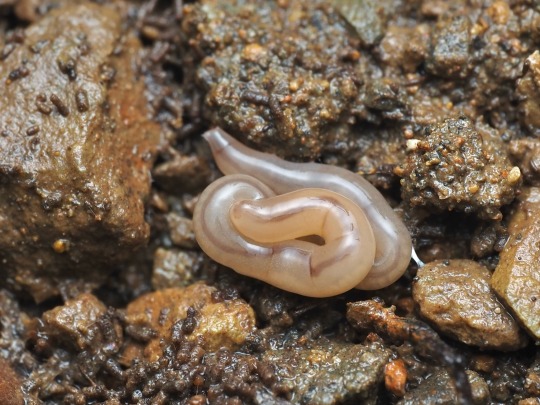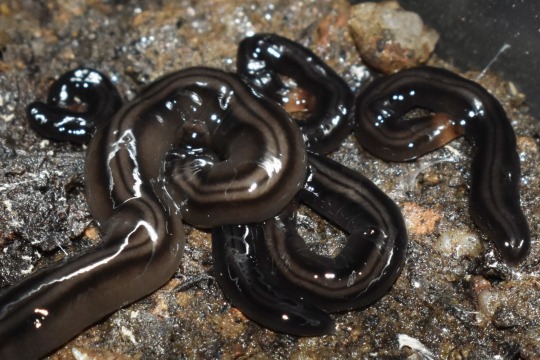#Geonemertes
Text
realized I hadn’t fed my Geonemertes in two weeks, so I offered it an isopod. didn’t expect to see it strike, so the video isn’t the sharpest, but what a cool way of hunting!
the worm fires its sticky proboscis like a harpoon, presumably injecting venom at some point.
this is Geonemertes pelaensis, one of a scant few terrestrial examples of a mostly marine phylum (Nemertea). it’s an invasive species in the US and elsewhere, implicated in lowering counts of some soil arthropods.


it also has a very cute face.

2K notes
·
View notes
Photo


Genus Geonemertes
...a genus of terrestrial nemertean (ribbon) worms that are distributed throughout Indonesia, some Indo-Pacific islands, and parts of Australia. Members of Geonemertes are often found in the leaf litter and on plants and reportedly have a diet that includes insects and other arthropods. Like their marine relatives, members of Geonemertes feed by shooting out their proboscis which can stretch to almost their entire body length. Like most terrestrial ribbon worms this group is poorly researched and much is still unknown about their biology and ecology.
Phylogeny
Animalia-Nemertea-Enopla-Hoplonemertea-Monostilifera-Geonemertes
Image Source(s)
#Geonemertes#Nemertea#Animals#Science#Ribbon Worm#Enopla#Indonesia#Oceania#Indo-Pacific#Australia#nemertean#Hoplonemertea#Monostilifera
132 notes
·
View notes
Text
just watched this Geonemertes pelaensis catch a wolf spider! these terrestrial ribbon worms hunt by firing their proboscis at prey like a harpoon, envenomating them. this spider stopped moving instantly after the proboscis made contact—I’ll try to get a video of it next time… one of the most bizarre hunting techniques I’ve seen.
1K notes
·
View notes
Text




some invasive worms I found in Florida!
first is a Caenoplana sp., a flatworm now found across the tropics but which is likely native to Australia (or nearby). they feed on arthropods, including isopods.
next is Bipalium vagum, the Wandering Hammerhead Flatworm. its specific name alludes to the fact that it too has spread itself throughout the tropics. its close relatives in the US are also probably native to East Asia, but while those eat only earthworms, B. vagum feeds on only snails. Bipalium are known to produce tetrodotoxin, a nasty poison responsible for the toxicity of fugu pufferfish.
third is an Anisorhynchodemus sp., and its original distribution is also unknown. the genus it’s placed in is essentially a wastebasket—all the rhynchodemine flatworms that can’t be connected with an older, outdated classification method get lumped there. these guys are predators of arthropods, and also love sucking isopods out of their shells. when seized, they cleave their own rears off; the biggest one I have failed to autotomize its tail completely and now has two tails (not pictured).
despite a similar appearance, the last isn’t a flatworm, but an entire different phylum of animals! the nemertean (ribbon worm) Geonemertes pelaensis is just one of 13 species of nemertean that live on land with the remaining 1,300 living in saltwater. and, you guessed it, it’s native to *somewhere in the Indopacific* and is now found all over the tropics because of humans transporting it accidentally with soil. it is a predator of small arthropods, including spiders and isopods, which it captures with a sticky, venomous projectile proboscis. good video of that on its Wikipedia page.
so yeah that’s my worms. hope you like the worms
928 notes
·
View notes